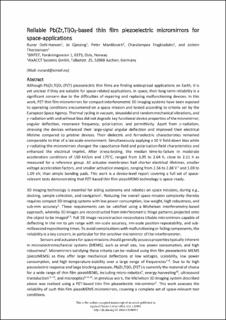| dc.contributor.author | Dahl-Hansen, Runar Plunnecke | |
| dc.contributor.author | Gjessing, Jo | |
| dc.contributor.author | Mardilovich, Peter | |
| dc.contributor.author | Fragkiadakis, Charalampos | |
| dc.contributor.author | Thorstensen, Jostein Bruun | |
| dc.date.accessioned | 2023-03-03T11:57:29Z | |
| dc.date.available | 2023-03-03T11:57:29Z | |
| dc.date.created | 2022-11-30T14:53:55Z | |
| dc.date.issued | 2022 | |
| dc.identifier.citation | Applied Physics Letters. 2022, 121 (13), 132901. | en_US |
| dc.identifier.issn | 0003-6951 | |
| dc.identifier.uri | https://hdl.handle.net/11250/3055734 | |
| dc.description.abstract | Although Pb(Zr,Ti)O3 (PZT) piezoelectric thin films are finding widespread applications on Earth, it is yet unclear if they are suitable for space-related applications. In space, their long-term reliability is a significant concern due to the difficulties of repairing and replacing malfunctioning devices. In this work, PZT thin film micromirrors for compact interferometric 3D imaging systems have been exposed to operating conditions encountered on a space mission and tested according to criteria set by the European Space Agency. Thermal cycling in vacuum, sinusoidal and random mechanical vibrations, and 𝛾-radiation with and without bias did not degrade key functional device properties of the micromirror such as angular deflection, resonance frequency, polarization, and permittivity. Apart from 𝛾-radiation, stressing the devices enhanced their large-signal angular deflection and improved their electrical lifetime compared to pristine devices. Their dielectric and ferroelectric characteristics remained comparable to that of a lab-scale environment. Simultaneously applying a 10 V field-down bias while 𝛾-radiating the micromirrors changed the capacitance-field and polarization-field characteristics and enhanced the electrical imprint. After stress-testing, the median time-to-failure in moderate acceleration conditions of 150 kV/cm and 175 °C ranged from 1.95 to 2.64 h, close to 2.11 h as measured for a reference group. All actuator membranes had shorter electrical lifetimes, smaller voltage acceleration factors, and smaller activation energies, ranging from 2.56 to 2.88 V−1 and 1.03 to 1.09 eV, than simple bonding pads. This work is a device-level report covering a full set of space-relevant tests demonstrating that PZT-based thin film piezomicroelectromechanical systems technology is space-ready. | en_US |
| dc.language.iso | eng | en_US |
| dc.publisher | AIP Publishing | en_US |
| dc.title | Reliable Pb(Zr,Ti)O3-based thin film piezoelectric micromirrors for space-applications | en_US |
| dc.title.alternative | Reliable Pb(Zr,Ti)O3-based thin film piezoelectric micromirrors for space-applications | en_US |
| dc.type | Peer reviewed | en_US |
| dc.type | Journal article | en_US |
| dc.description.version | acceptedVersion | en_US |
| dc.source.pagenumber | 1-8 | en_US |
| dc.source.volume | 121 | en_US |
| dc.source.journal | Applied Physics Letters | en_US |
| dc.source.issue | 13 | en_US |
| dc.identifier.doi | 10.1063/5.0106933 | |
| dc.identifier.cristin | 2085948 | |
| dc.source.articlenumber | 132901 | en_US |
| cristin.ispublished | true | |
| cristin.fulltext | original | |
| cristin.fulltext | postprint | |
| cristin.qualitycode | 2 | |
